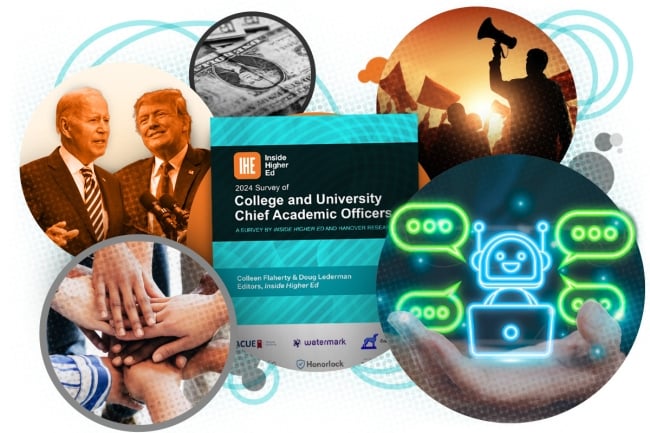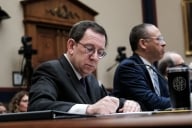You have /5 articles left.
Sign up for a free account or log in.

The 2024 Survey of College and University Chief Academic Officers is out now.
Photo illustration by Justin Morrison/Inside Higher Ed | McKinsey and Sataphorn Srijantra/RawPixel | Barriography, Tasos Katopodis and Alex Wong/Getty Images
In the latest annual survey by Inside Higher Ed, participating provosts said the vast majority of their institutions have not yet published policies governing the use of artificial intelligence (AI), even as its power and disruptive potential increase. And most institutions haven’t reviewed curriculum to ensure it will prepare students for AI’s rise in the workplace.
The email survey, conducted in February and March in conjunction with Hanover Research, asked about the multiple challenges that face higher education following a tumultuous year. At a time when diversity, equity and inclusion programs are under attack, around 70 percent of the respondents rated race relations on their own campuses as good or excellent—yet only about 30 percent said the same for higher education as a whole. And, as Israel’s war in Gaza continues and a presidential election looms, nearly four in 10 provosts said world events have stressed their institutions’ speech policies to the point they may need revisions.
These are just some results of the wide-ranging 2024 Survey of College and University Chief Academic Officers, which also polled provosts about typical academic and university management issues that have become atypically fraught in a time of tight budgets, enrollment declines and political heat. Should degree programs be cut? How viable is tenure? Has employee turnover increased? The 331 provosts who returned full or partial surveys—respondents were about evenly split between public and private nonprofit institutions—gave their views on those questions along with a range of challenges higher education faces.
Artificial Intelligence
As with Inside Higher Ed’s 2024 presidents’ poll, this marks the first time our annual provosts’ survey asked about AI. The questions come at an important moment: Generative AI has advanced rapidly over the past year, raising the specter of widespread abuse by both students and faculty members who can use it to produce journal articles that read like unassisted humans wrote them.
Are provosts and their institutions ready to meet this moment? By one measure, not yet: Only one in five said their college or university has published a policy governing the use of AI, including in teaching and research.
Gregor Thuswaldner, provost at Whitworth University and president of the Association of Chief Academic Officers, said that percentage does seem low “at first glance.” But he noted that “for many institutions, their plagiarism policies kind of govern also generative AI—that is, students are forbidden to use anything that is not their own work.” Whatever the case, many provosts may soon catch up: 63 percent said an AI policy is in the works at their institutions.
Only about one in seven provosts said their colleges or universities had reviewed the curriculum to ensure it will prepare students for AI in their careers. Thuswaldner said that number needs to rise. “AI is here to stay, and we cannot put our heads in the sand,” he said. “Our world will be completely dominated by AI and, at this point, we ain’t seen nothing yet.”
Nearly half of the provosts said they’re moderately concerned about generative AI’s threat to academic integrity, with a further 26 percent saying they’re very or extremely concerned. George Justice, the University of Tulsa’s provost, said he has one dean who’s “terrified about the implications for academic integrity” and wants to ban the use of generative AI on any assignments in her college—while another dean is surveying every course to see whether it’s maximizing AI’s use to prepare students for the future.
Justice said it’s good for AI policies to allow “widely divergent approaches” in classrooms. But he cautions that faculty members who merely ban AI and don’t change how they teach in response to it are going to face widespread cheating. “Not because students are evil,” he said, but because they have a “bullshit detector, and if professors are pretending that the real world isn’t happening then they become cynical about the requirements in a class.”
Thuswaldner advocated for more in-class writing and focusing on “process rather than product.” If AI can produce what universities are asking students to do, he said, “then we’re probably asking the wrong question.”
Provosts don’t see AI merely as a threat to be kept at arm’s length. In fact, only 2 percent of respondents said they’re not at all enthusiastic about its potential benefit to their institutions’ capabilities, and 45 percent say they’re using it for chatbots and virtual chat assistants. Employees appear to be clamoring for help with the technology—nine in 10 provosts said faculty and staff members have requested more training related to generative AI developments.
The provosts said they’re responding to that demand: Nearly 80 percent said their colleges and universities have offered training in response to faculty concerns or questions within the last year and a half.
Campus Speech and the 2024 Election
Raucous campus protests over the war in Gaza, faculty members’ controversial social media posts about the violence and even congressional interrogations of university presidents over antisemitism have drawn the nation’s eyes upon academe. And the war is just one issue in the upcoming elections featuring a rematch between Joe Biden and Donald Trump for the presidency. “There will be more student protests and, yeah, this will be certainly a fall to remember on campuses,” Thuswaldner said.
More than half of the provosts surveyed said they’re very or extremely concerned about this year’s election results affecting their institution’s climate for free inquiry. And then there’s all the time leading up to the election, when Thuswaldner said he’s sure there will be more campus unrest. “I don’t think you have to be a prophet to make that prediction,” he said.
More on the Survey
Inside Higher Ed’s 2024 Survey of College and University Chief Academic Officers was conducted by Hanover Research. The survey included 331 presidents from public and private institutions for a margin of error of 5.04 percent. A copy of the free report can be downloaded here.
On May 15, at 2 p.m. E.T., Inside Higher Ed will present a webcast to discuss the results of the survey. Please register here.
This Inside Higher Ed Survey of College and University Chief Academic Officers was made possible by support from ACUE, Watermark, Coursedog, Interfolio from Elsevier, Honorlock and The Honor Society of Phi Kappa Phi.
So how do provosts assess the free speech situation, as of now? More than 60 percent of respondents did rate the climate for open inquiry and dialogue on their campuses as good or excellent, but only 27 percent said the same for higher education writ large. “It is kind of amusing that we all think we’re doing it right,” Justice said. But what “open inquiry” means is itself contested, he noted, and there’s so much contention “over what doing it right might mean.”
For instance, Justice said he and his institution adhere to the Chicago Principles, the University of Chicago’s widely adopted free expression statement. The statement says, in part, that “concerns about civility and mutual respect can never be used as a justification for closing off discussion of ideas, however offensive or disagreeable those ideas may be to some.” However, Justice said other provosts might justify a different approach by saying “we’ve created structures that exclude outrageous speech that actually distorts what open inquiry at a university is supposed to be.”
Despite the overall rosy view of open inquiry on their own campuses, nearly 40 percent of provosts said world events have stressed their institutions’ speech policies to the point they may need revisiting. And about three-quarters of respondents said their colleges and universities have already taken some action to teach students and employees about the importance of free speech and to prepare them to engage with those they disagree with. “Pluralism and democracy go hand in hand, that’s exactly what we need to prepare students for,” Thuswaldner said.
We also asked provosts whether their institutions had clear response plans for responding to various speech-related concerns. Among the findings: Only 36 percent said they had a clear policy to respond to student complaints about professors’ extramural speech, and just 31 percent said they had a policy to deal with online trolling or other outside attacks on professors—a not-uncommon situation that faculty members have faced after posting about the war in Gaza.
Diversity, Equity and Inclusion
About 60 percent of respondents said the Supreme Court decision last year banning race-based admissions will decrease student racial diversity in higher education as a whole. But only 11 percent said the same for their own specific institutions. This may indicate that some institutions that previously practiced race-conscious admissions have found workarounds or otherwise adapted to the decision. But there’s also the fact that only a sliver of institutions, typically highly selective, ever practiced race-conscious admissions in the first place.
Most provosts—slightly more than 70 percent—rated race relations on their own campuses as good or excellent, while just 2 percent said they were poor. Yet, asked about higher education as a whole, slightly fewer than 30 percent said race relations were good or excellent, and more than 70 percent characterized them as fair or poor.
Justice said these findings tell him that “many of us believe we are making good-faith efforts on our campus, regardless of whether we have DEI offices or not.” Republican lawmakers have targeted DEI offices and programs at public institutions in multiple states, with Florida banning the use of state and federal money on DEI programming and Texas outright banning the programs statewide.
While racism persists in society, young people are “fairly harmonious … at least on our campuses,” Justice said. “I think that we have a kind of a local perspective, but a national fear, and I’m hopeful that the local perspective is the true perspective,” he said.
Thuswaldner said that provosts may see their own campuses through “rose-colored glasses.” With DEI being curtailed in the South and elsewhere, he said “I think provosts have reason to be pessimistic that things will not necessarily develop in a positive way going forward.”
About a tenth of provosts said they had scaled back diversity and inclusion efforts beyond admissions in response to the high court decision or other pressure coming from lawmakers. But that percentage grows to 41 percent when just looking at the responses from provosts at Southern public institutions.
Academic Program Cuts
The West Virginia University Board of Governors’ vote last year to eliminate of all of its foreign language degree programs and other offerings sent a shockwave through academe, which hadn’t seen a public flagship research university carry out that level of cuts in modern memory. But multiple smaller institutions have also eliminated offerings in response to declining enrollment and other challenges.
More cuts may be coming. More than 40 percent of provosts who participated in the survey agreed or strongly agreed that their institutions should cut their number of academic programs by the end of next academic year, while 35 percent said their college or university was actually likely to do so. Meanwhile, the prospects for new or expanded academic programs appear dim: About 75 percent of provosts agree or strongly agree that most “new” program spending at their institutions will have to come from reallocating dollars.
Faculty and Staff Turnover
The targeting of tenure, shared governance and certain academic disciplines by conservative lawmakers and university trustees has fed concerns that faculty members will flee states where this is occurring, though it’s still unclear whether this is coming to pass. Nationwide, there’s also another possible source of attrition: Inflation has cut into pay, and workers want raises.
Around two-thirds of provosts who responded to the survey said their institutions were seeing higher-than-usual turnover rates for staff specifically. Thirty-five percent of provosts said the same of faculty members. And most—60 percent—said recruiting faculty members is harder now than before the pandemic.
A greater share of respondents from private nonprofit colleges and universities reported seeing higher employee turnover, compared to provosts at public institutions. At the same time, a lower rate of private nonprofit provosts said their institutions had recently changed compensation, and a lower rate said their institutions were doing more than before the pandemic to retain and engage faculty members.
Across higher education, only about 40 percent of provosts say their college or university is doing more now to retain and engage faculty members than before COVID-19.
“What you described there doesn’t surprise me at all,” said Todd Benson, executive director of the Collaborative on Academic Careers in Higher Education at Harvard University. His data shows academics are starting to look more broadly at careers outside of academe, where they can find better compensation and work-life balance. Faculty members are facing increasing demands, he noted, including more teaching expectations, a longer process for publications and grants and a higher bar to earn tenure.
“This generation of faculty that are coming up now are more cognizant of the fact that getting a tenure line is a bit more of a unicorn than it used to be, and so they don’t have the same sense of opportunity and security that they may have had 10 or 20 years ago,” Benson said. He said “they're going into it with much more open eyes and so they’re being much more flexible with themselves.”
Tenure or Long-Term Contracts?
The proportion of higher education faculty members who are not on the tenure track has been growing for decades. Respondents gave an interesting mix of answers on the future of tenure.
Provosts were polled on how “viable” tenure is within their institutions, and were asked to think when answering about “how well tenure works at your institution along with its likelihood to endure.”
More than 60 percent responded that tenure is very or extremely viable. Half of the provosts said it’s very or extremely important to their institutions’ health. Yet more than half also said they favor a system of long-term contracts for tenure-track and tenured faculty members over the existing tenure system.
Provosts may in principle support tenure but in practicality be seeking more flexibility than it traditionally provides. Benson said long-term contracts allow university leaders to make cuts more easily when budgets get tight, but they also send “a tacit signal to faculty that you may not be here” in the future. “Tenure was the institution’s promise to faculty, and the more we erode that, the less that faculty feel like they have a commitment from the institution,” he said.
Noting the declining public perception of higher education alongside the increased work demands, Benson said “more and more faculty are not feeling that sense of value.” Only 22 percent of provosts said their institution is very good at recruiting and retaining talented faculty members.
Non-tenure track faculty members don’t seem to be going away soon. Nearly two-thirds of provosts said their institution will rely just as much on them in two years from now or in the near future. And a further 23 percent said they expect to rely on them more.
About 46 percent of provosts agreed or strongly agreed that graduate programs admit too many doctoral students given the job market. Those most in agreement with this sentiment were provosts at public doctoral institutions, where 61 percent felt the programs admit too many people.
Recognizing Mental Health Needs
Huge majorities of the responding provosts said they’re either somewhat or very aware of the general state of mental health across various campus constituencies: 97 percent when it comes to undergraduates and 95 percent for faculty members.
Forty-five percent of provosts said their institution offers leaders optional training to help them support faculty and staff members’ mental health, but only 20 percent said training was required.
Course Materials Models
The provosts’ views on textbooks may be welcome news for cash-strapped students: Around 60 percent agreed or strongly agreed that free, open educational resources are of high enough quality that they should be used in most general education courses. And 70 percent of the respondents said their institution had adopted these materials.
About a third of respondents said their institutions had adopted an “inclusive access” model, where the learning materials are digital-first with an opt-out option.
Institutional Effectiveness and the Provost’s Role
Provosts gave their institutions high marks at providing quality undergraduate education: 72 percent said their colleges and universities were very effective, and another 27 percent said somewhat effective. But they were more muted, while still majority positive, about the job their institutions were doing in preparing students for work: 57 percent very effective, 41 percent somewhat effective.
About 40 percent of provosts somewhat or strongly agree that their jobs focus more on financial management than academics. But nearly 90 percent say, nonetheless, that they’re glad they pursued administrative work.



f917.jpg?itok=cjynvv9F)